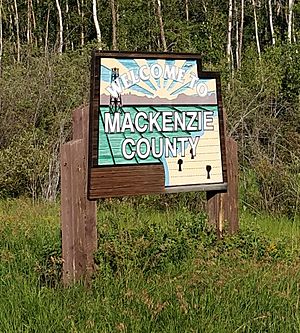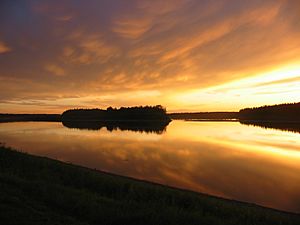Mackenzie County facts for kids
Quick facts for kids
Mackenzie County
|
||
|---|---|---|
|
Specialized municipality
|
||

Welcome sign
|
||
|
||

Location within Alberta
|
||
| Country | Canada | |
| Province | Alberta | |
| Region | Northern Alberta | |
| Planning region | Lower Peace | |
| Incorporated - Municipal district |
January 1, 1995 |
|
| - Specialized municipality | June 23, 1999 | |
| Name change | March 8, 2007 | |
| Area
(2021)
|
||
| • Land | 79,629.26 km2 (30,745.03 sq mi) | |
| Population
(2021)
|
||
| • Total | 12,804 | |
| • Density | 0.2/km2 (0.5/sq mi) | |
| • Municipal census (2018) | 12,514 | |
| Time zone | UTC−7 (MST) | |
| • Summer (DST) | UTC−6 (MDT) | |
| Website | mackenziecounty.com | |
Mackenzie County is a specialized municipality in northern Alberta, Canada. It is located in Census Division 17, along the Mackenzie Highway. The municipal office is located in the hamlet of Fort Vermilion.
History
Originally Improvement District No. 23, the Municipal District of Mackenzie No. 23 incorporated as a municipal district on January 1, 1995. It subsequently changed its status to specialized municipality on June 23, 1999 "to address concerns about municipal government and management in a municipality that serves a number of unique communities within a very large territory." The Municipal District of Mackenzie No. 23 changed its name to Mackenzie County on March 8, 2007.
Geography
Mackenzie County is in the northwest corner of the province of Alberta. It borders the province of British Columbia to the west; the Northwest Territories to the north; Improvement District No. 24 (Wood Buffalo National Park) and the Regional Municipality of Wood Buffalo to the east; and Northern Sunrise County, the Paddle Prairie Metis Settlement, and the County of Northern Lights to the south. The Peace River meanders eastward through the southeast portion of Mackenzie County. Some of its water bodies include Bistcho Lake, Eva Lake, Margaret Lake, Wadlin Lake, Wentzel Lake, and Zama Lake. Land formations include Bootis Hill in the northwest, the Caribou Mountains in the northeast, Buffalo Head Hills in the south, Cameron Hills in the north, and Mount Watt northwest of the Town of High Level.
Communities and localities
|
The following urban municipalities are surrounded by Mackenzie County.
|
The following hamlets are within Mackenzie County.
|
The following localities are within Mackenzie County.
- Localities
|
|
The following settlements are within Mackenzie County.
- Settlements
|
|
First Nations have the following Indian reserves within Mackenzie County.
- Indian reserves
Demographics
|
||||||||||||||||||||||||||||||
In the 2021 Census of Population conducted by Statistics Canada, Mackenzie County had a population of 12,804 living in 3,516 of its 3,756 total private dwellings, a change of 14.6% from its 2016 population of 11,171. With a land area of 79,629.26 km2 (30,745.03 sq mi), it had a population density of 0.2/km2 (0.52/sq mi) in 2021.
The population of Mackenzie County according to its 2018 municipal census is 12,514, a change of 6.5% from its 2015 municipal census population of 11,750.
In the 2016 Census of Population conducted by Statistics Canada, Mackenzie County had a population of 11,171 living in 3,088 of its 3,567 total private dwellings, a change of 2.2% from its 2011 population of 10,927. With a land area of 80,458.19 km2 (31,065.08 sq mi), it had a population density of 0.1/km2 (0.26/sq mi) in 2016.
Attractions
Mackenzie County is home to Caribou Mountains Wildland Provincial Park and Hay-Zama Lakes Wildland Provincial Park. It is also adjacent to Wood Buffalo National Park to the east.



